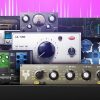-
 play_arrow
play_arrow
Clubalicious Clubalicious Radio
-
 play_arrow
play_arrow
London Calling Podcast Yana Bolder

So many new pro audio and music products are released each year that it becomes difficult to make fair comparisons or put together a “Best Of” or “Top 25” list. How do you choose when presented with a new $10,000 single-channel analog compressor and a $79 distortion plug-in? In that spirit, please consider this our annual “Must-Have” list, where there’s something for every type of audio pro.
To put together this year’s selection, we asked longtime Mix contributors and product reviewers Steve La Cerra, Mike Levine, Rich Tozzoli, Barry Rudolph and Michael Cooper to send in a few of their favorites. Here, presented in alphabetical order, are those selections. (Don’t Pass Up Parts 1, 2 and 3!)
TELEFUNKEN USA TF17 FET

Telefunken has a pretty long history in making high-quality condenser microphones, and that continues with a new, lower-cost lineup in Telefunken Elektroakustic USA’s Alchemy Series. The new TF11 and TF 17 FET, and the TF29 Copperhead tube, are cardioid-only models; the TF47 and TF51 tube mics are multi-pattern.
The TF17 is an everyday, workhorse microphone that comes with a stand mount and recessed XLR connector. I like its size for fitting into tight places, such as under the lid of a piano or near drums and percussion instruments on live stages. Max SPL is 135 dB, and I found it to clip only occasionally on loud drum kits. It has a 34mm, center-terminated, K47-style, single-membrane capsule and a nickel-iron core output transformer made in England by OEP Carnhill Transformers. These microphones are all made in America and construction is first class, with discrete components hand-soldered on a circuit board—no surface-mount construction here.
I liked its forward sound with a broad presence boost in the 4kHz region—a mid-forward German voicing. This sounded great for most singers to give them more “cut” for Pop music. I also liked using the TF17 for both acoustic and electric guitars. I recorded a Yamaha acoustic about a foot away from where the neck joins the body. This was a good location
for both strumming and finger-picking guitar parts. The electric guitar sound I got with TF17 was crisp and more transparent than my usual SM7B dynamic, with the TF17 capturing the transients more accurately.
For a small drum kit, a single TF17 about four feet overhead centered over the bass drum pedal’s beater was the best one-microphone drum sound I’ve ever gotten.
The TF17 has proven to be an awesome all-around utility microphone and a good value as an introduction to the Telefunken name! —Barry Rudolph
THREE-BODY TECHNOLOGY CENOZOIX COMPRESSOR

With all the compressors on the market, what makes this plug-in so unique? It’s a chameleon that can emulate the major compressor designs, including VCA, opto, FET and tube. It also offers unusually deep control over the compression behavior and a stellar user interface.
The Three-Body Technology Cenozoix Compressor (distributed by Plugin Alliance) features 24 individual compressor emulations. Twelve are modeled after classic hardware such as the 1176, LA-2A, Fairchild 670, Neve 2254 and many others, and the others are original designs from TBT. Many of the latter are aimed at specific compressor behaviors, sources or mixing applications. Examples include Tight, Vocal, Pluck, Drum, Loud, Bus and Mastering.
One of this product’s most valuable attributes is that it allows users to easily compare multiple compressor types as audio plays. When you select any of the available compressors, the controls change correspondingly. In addition to standard parameters like Threshold, Ratio, Attack, Release, Knee and Makeup (gain), TBT has added some unique and powerful adjustments.
For example, the Clamp knob controls transients without the necessity to set a fast attack time. De-Click makes transients sound less clicky. My favorite is the Punch/Pump slider, which lets you alternatively emphasize transients or sustain. On some models, you can switch between feedback and feed-forward operation.
The GUI makes it easy to see the impact of your selections and adjustments. The soundwaves move from left to right in real time, and a downward-facing green line indicates gain reduction. —Mike Levine
UNIVERSAL AUDIO RUBY 63, DREAM 65 AND LION 68

This trio of UAD Native guitar amp plug-ins are based both on the real amps, as well as UA’s own hardware-equivalent pedals. My favorite is the Dream ’65 Reverb Amp, based on the classic Fender model of that era. Aside from vintage tones and a killer reverb and tremolo, the team at UA added some bonus “mods” that guitar players like me live for. When you flip to the Lead selection, the bright cap is “removed” and the boost is enabled, allowing for some ripping rock/blues tones. Switching to D-Tex, it’s a mod that was done for Stevie Ray Vaughn, with a creamy mid- overdrive sound. Also included are six cab and mic combinations, delivering even more flexibility.
The Lion 68 goes for the classic British Marshall sound. It features three “golden unit,” 100-watt Plexi amp heads, along with cabs and mics. The amp rips, and plugging in a Les Paul makes you want to play. It’s got that snotty Marshall mid and a ton of fat lows, but it can also deliver some classic clean sounds, just like the real heads can.
The third in this trio is the Ruby ’63 Top Boost amp, modeled after a vintage VOX “valve” amp. I appreciate the inclusion of effects such as Galaxy tape echo, Dallas Rangemaster treble boost and a Room knob to dial in some super vibe-y distance. The modes include Vib-Trem, Norman and Brilliant, which includes an extra tube for more gain and treble. There’s a choice of six cab/mic combos, including my favorite, the 15W Celestion Silver Buldog 2X12 with a 57 mic. There’s no denying the UA team did their work on this trio! —Richard Tozzoli
UNIVERSAL AUDIO VERVE ANALOG MACHINES

Plenty of plug-ins are available for infusing digital recordings with analog characteristics, including modeled preamps, tape machines and other processor types. Well, imagine the utility of a plug-in that features an array of tape machines and preamp emulations, ranging from subtle warmth to crushing distortion, that you can switch between with a simple button push. Verve Analog Machines does that.
This easy-to-use plug-in lets you select one of 10 “Machines” to run your track, bus or mix through. UA created the Machines as generic representations of six tape recorders and four preamps, ranging from studio units to obscure consumer models. UA gave them names corresponding to their effect on the audio, such as Glow, Edge, Vintagize, Distort, Overdrive and so on.
The Machines are arranged from left to right, with the cleanest one, Sweeten, on the left and the most distorted one, Sputter, on the right. A row of color-coded buttons running across the upper part of the screen makes choosing the desired Machine easy. When you select one, a nifty graphic depiction of it appears in the middle of the screen.
In addition to an Output Level slider, each preamp has Drive and Tone knobs, and each tape machine has Drive and Warble knobs. You also see the input and output levels depicted in horizontal meters. With its simple control set, Verve Analog Machines will appeal to novice users, but its vast variety of excellent sounds makes it a product that will be at home in any studio’s collection. —Mike Levine
WOLFF AUDIO FREQ EQ 500 SERIES

Famed audio designer Paul Wolff’s Freq EQ, which he calls “the everything EQ,” is a single-channel, four-band proportional-Q equalizer packed into a single 500 Series module. My pair of Freqs, in a Wolff Bucket 500 Rack, is positioned within reach while sitting in the sweet spot, and the familiar lineup of controls with center-positioned detents and lit-up buttons makes the Freq EQ my “go-to” equalizer for recording/tracking, mixing and/or fixing audio.
The controls start at the top with the High frequency section (2 kHz to 20 kHz) and at the bottom with the Low frequency section (25 Hz to 700 Hz). The Wide buttons change these bands between proportional-Q and a conventional 1/3-octave, bell-shape EQ. This super-smooth Wide mode is Wolff’s version of a shelving EQ. But unlike a shelving equalizer, which continues to boost or cut out to the extremes, a constant-Q, bell-shape starts to roll off above and below the selected frequency(s).
The Freq’s midrange section is divided into the High Mid-Range (350 Hz to 10 kHz) and Low Mid-Range sections (75 Hz to 2 kHz). Both sections have their own fixed-Q, 1/3rd octave switches, with the default position being proportional-Q. In the studio, the Freq EQ is indispensable for subtle touch-ups, any kind of mixing, or carving out fixes for broken audio. I can recommend at least a pair of them, if not a whole rack of them! —Barry Rudolph
Written by: Admin
Similar posts
Recent Comments
No comments to show.Featured post

Latest posts
Current show
Upcoming shows

Made To Move
Jacob Colon
19:00 - 20:00
In Session
Sister Bliss
20:00 - 21:00
Fresh Is Fresh
This Weeks Hottest Releases
21:00 - 00:00
Uplifting Only
Ori Uplift
00:00 - 02:00
Fresh Is Fresh
This Weeks Hottest Releases
02:00 - 09:00Chart
Powered by Dee jay promotions visit us













 Invalid license, for more info click here
Invalid license, for more info click here